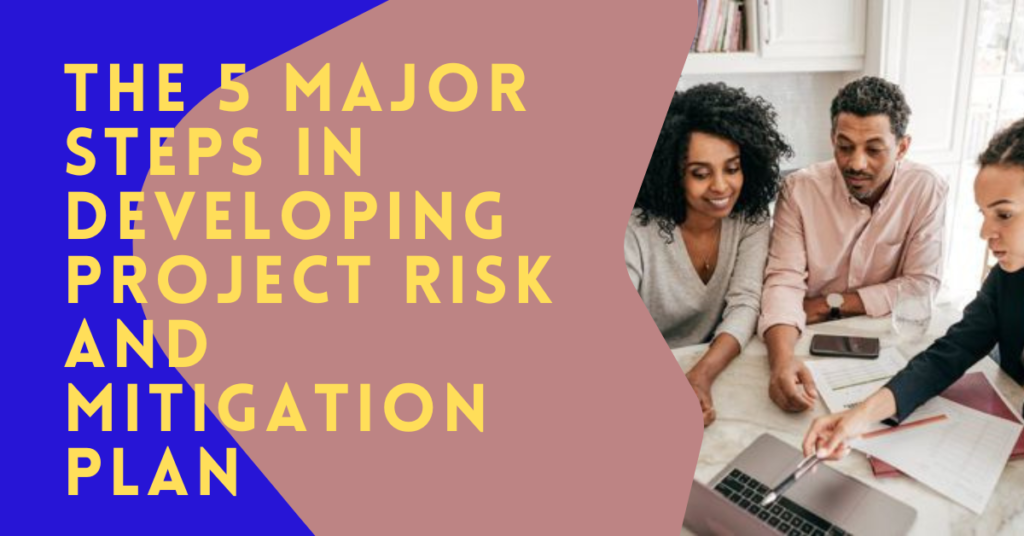
Menu
Facebook-f
Twitter
Google-plus-g
The 5 Major Steps in Developing Risk and Mitigation Plan
Project risk and mitigation planning is essential for ensuring that your NGO’s projects run smoothly and achieve their goals. It involves identifying potential risks that could affect your project and developing strategies to minimize or manage these risks. This guide will walk you through the steps of creating a risk and mitigation plan in simple terms, so you can protect your project from potential issues and challenges.
Step 1: Identify Potential Risks
Why Identifying Risks is Important:
Identifying potential risks helps you anticipate problems before they occur. This allows you to prepare and implement strategies to handle these risks effectively.
How to Identify Risks:
- Brainstorm with Your Team: Gather your team and discuss possible risks related to your project. Consider factors such as financial, operational, and external risks.
- Review Past Projects: Look at similar projects you have completed before. What problems did you encounter? Use these past experiences to identify similar risks for your current project.
- Consult Stakeholders: Talk to stakeholders, including beneficiaries, partners, and donors, to get their perspectives on potential risks.
Example:
If your NGO is launching a new educational program, potential risks might include insufficient funding, low community participation, or delays in receiving educational materials.
Step 2: Assess the Impact and Likelihood of Risks
Why Assessment Matters:
Assessing the impact and likelihood of each risk helps prioritize which risks to address first. This ensures that you focus your efforts on the most critical risks.
How to Assess Risks:
- Evaluate Impact: Determine how serious the risk would be if it occurred. Would it have a major or minor effect on your project’s success?
- Evaluate Likelihood: Estimate how likely it is that the risk will actually occur. Is it a high or low probability?
- Create a Risk Matrix: Use a simple risk matrix to plot risks based on their impact and likelihood. This helps visualize which risks are most critical.
Example:
For the educational program, a risk of insufficient funding might have a high impact (it could halt the program) and a medium likelihood (funding can be challenging but is not impossible). In contrast, a delay in receiving materials might have a moderate impact and a high likelihood.
Step 3: Develop Mitigation Strategies
Why Mitigation Strategies are Essential:
Mitigation strategies are actions you take to reduce the impact or likelihood of risks. They help you manage risks proactively and minimize their potential effects.
How to Develop Strategies:
- Identify Solutions: For each identified risk, determine what actions you can take to avoid or reduce the risk. Think about how you can address the risk if it occurs.
- Assign Responsibilities: Decide who will be responsible for implementing each mitigation strategy. Ensure that the person or team understands their role and responsibilities.
- Set Timelines: Establish deadlines for implementing each strategy. This helps ensure that risks are managed in a timely manner.
Example:
For the risk of insufficient funding, a mitigation strategy could be to diversify your funding sources by applying for multiple grants and organizing fundraising events. Assign the task of grant writing to a specific team member and set deadlines for applying for grants.
Step 4: Create a Risk Management Plan
Why a Plan is Necessary:
A risk management plan outlines how you will handle risks throughout the project. It serves as a reference guide for your team to follow when managing risks.
How to Create a Plan:
- Document Risks and Strategies: Write down all identified risks, their impact and likelihood, and the corresponding mitigation strategies.
- Include Contingency Plans: Develop contingency plans for each risk, detailing what actions to take if a risk occurs despite your mitigation efforts.
- Communicate the Plan: Share the risk management plan with your team and stakeholders. Ensure everyone understands their roles in managing risks.
Example:
Your risk management plan for the educational program might include sections on funding risks, participation risks, and material delivery risks. Each section would outline the risks, mitigation strategies, contingency plans, and assigned responsibilities.
Step 5: Monitor and Review Risks
Why Monitoring is Important:
Ongoing monitoring ensures that risks are being managed effectively and that new risks are identified as they arise. Regular review helps keep the risk management plan up-to-date.
How to Monitor and Review:
- Regular Check-Ins: Schedule regular meetings to review the status of identified risks and mitigation strategies. Adjust strategies as needed based on the project’s progress and any new risks that arise.
- Update the Plan: Revise the risk management plan based on your monitoring and any changes in the project. Add new risks and update mitigation strategies as required.
- Gather Feedback: Collect feedback from team members and stakeholders on the effectiveness of the risk management plan. Use this feedback to make improvements.
Example:
If you encounter a new risk during the project, such as a sudden change in community needs, update your risk management plan to include this new risk. Adjust your mitigation strategies and communicate these changes to your team.
Conclusion
Developing a risk and mitigation plan is crucial for managing potential problems and ensuring the success of your NGO project. By identifying risks, assessing their impact and likelihood, developing mitigation strategies, creating a risk management plan, and monitoring risks regularly, you can protect your project from unforeseen issues and keep it on track.
Address List
-
Makerere Hill Road, Ham Towers -
+256-703947778 -
info@professionalwriters.shop
Social Networks
Links List
Professional Writers Inc.
Turning Ideas Into Reality
Business Plan Writing Training [Free]





